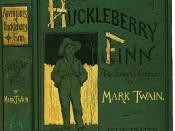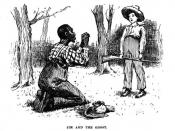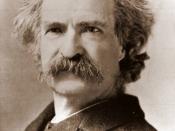Friendship Beyond Color The implication of race and a conscience in Huck Finn's life while he was escaping his past with fellow slave, Jim, becomes vital to the conclusion of The Adventures of Huckleberry Finn. We are introduced initially to Huck while he is residing at Widow Douglas' home. He portrays the "typical"ÃÂ kid to us: adventurous, playful, and innocent. All of these ideals suddenly disappear, though, as soon as Jim and Huck begin to descend down the river. It is the descent upon this river where the issue of race begins to become relevant.
One has to keep in consideration that Huck began this "adventure"ÃÂ as a child. Being a child, Huck was full of childish mannerisms and innocence that can quickly disappear with one incident. As Mark Twain stated during the movie, "a mind that becomes soiled in youth can never be washed clean again."ÃÂ It was the process of befriending Jim when the innocence of Huck's youth vanished.
Through Huck's eyes no apparent difference between he and Jim was evident. They each had a commonality of pursuing freedom; but it was on the raft when Huck began to realize the true impact of race.
For so much of his life, Huck was naÃÂïve to the color of his own skin or to the color of Jim's skin. Granted Huck acknowledged that Jim was a slave, but the revelation was made of the importance of race when Huck had to go ashore because he was "a white boy"ÃÂ. The color of skin became somewhat of a determining factor when they would begin their adventures ashore.
Even though the race of each man became important, ultimately though it was the friendship that built the lasting bond continuing throughout the book. Race was vital in determining some...


